Min Hou
Mitigating Recommendation Biases via Group-Alignment and Global-Uniformity in Representation Learning
Nov 17, 2025Abstract:Collaborative Filtering~(CF) plays a crucial role in modern recommender systems, leveraging historical user-item interactions to provide personalized suggestions. However, CF-based methods often encounter biases due to imbalances in training data. This phenomenon makes CF-based methods tend to prioritize recommending popular items and performing unsatisfactorily on inactive users. Existing works address this issue by rebalancing training samples, reranking recommendation results, or making the modeling process robust to the bias. Despite their effectiveness, these approaches can compromise accuracy or be sensitive to weighting strategies, making them challenging to train. In this paper, we deeply analyze the causes and effects of the biases and propose a framework to alleviate biases in recommendation from the perspective of representation distribution, namely Group-Alignment and Global-Uniformity Enhanced Representation Learning for Debiasing Recommendation (AURL). Specifically, we identify two significant problems in the representation distribution of users and items, namely group-discrepancy and global-collapse. These two problems directly lead to biases in the recommendation results. To this end, we propose two simple but effective regularizers in the representation space, respectively named group-alignment and global-uniformity. The goal of group-alignment is to bring the representation distribution of long-tail entities closer to that of popular entities, while global-uniformity aims to preserve the information of entities as much as possible by evenly distributing representations. Our method directly optimizes both the group-alignment and global-uniformity regularization terms to mitigate recommendation biases. Extensive experiments on three real datasets and various recommendation backbones verify the superiority of our proposed framework.
A Survey on Generative Recommendation: Data, Model, and Tasks
Oct 31, 2025Abstract:Recommender systems serve as foundational infrastructure in modern information ecosystems, helping users navigate digital content and discover items aligned with their preferences. At their core, recommender systems address a fundamental problem: matching users with items. Over the past decades, the field has experienced successive paradigm shifts, from collaborative filtering and matrix factorization in the machine learning era to neural architectures in the deep learning era. Recently, the emergence of generative models, especially large language models (LLMs) and diffusion models, have sparked a new paradigm: generative recommendation, which reconceptualizes recommendation as a generation task rather than discriminative scoring. This survey provides a comprehensive examination through a unified tripartite framework spanning data, model, and task dimensions. Rather than simply categorizing works, we systematically decompose approaches into operational stages-data augmentation and unification, model alignment and training, task formulation and execution. At the data level, generative models enable knowledge-infused augmentation and agent-based simulation while unifying heterogeneous signals. At the model level, we taxonomize LLM-based methods, large recommendation models, and diffusion approaches, analyzing their alignment mechanisms and innovations. At the task level, we illuminate new capabilities including conversational interaction, explainable reasoning, and personalized content generation. We identify five key advantages: world knowledge integration, natural language understanding, reasoning capabilities, scaling laws, and creative generation. We critically examine challenges in benchmark design, model robustness, and deployment efficiency, while charting a roadmap toward intelligent recommendation assistants that fundamentally reshape human-information interaction.
WeaveRec: An LLM-Based Cross-Domain Sequential Recommendation Framework with Model Merging
Oct 30, 2025



Abstract:Cross-Domain Sequential Recommendation (CDSR) seeks to improve user preference modeling by transferring knowledge from multiple domains. Despite the progress made in CDSR, most existing methods rely on overlapping users or items to establish cross-domain correlations-a requirement that rarely holds in real-world settings. The advent of large language models (LLM) and model-merging techniques appears to overcome this limitation by unifying multi-domain data without explicit overlaps. Yet, our empirical study shows that naively training an LLM on combined domains-or simply merging several domain-specific LLMs-often degrades performance relative to a model trained solely on the target domain. To address these challenges, we first experimentally investigate the cause of suboptimal performance in LLM-based cross-domain recommendation and model merging. Building on these insights, we introduce WeaveRec, which cross-trains multiple LoRA modules with source and target domain data in a weaving fashion, and fuses them via model merging. WeaveRec can be extended to multi-source domain scenarios and notably does not introduce additional inference-time cost in terms of latency or memory. Furthermore, we provide a theoretical guarantee that WeaveRec can reduce the upper bound of the expected error in the target domain. Extensive experiments on single-source, multi-source, and cross-platform cross-domain recommendation scenarios validate that WeaveRec effectively mitigates performance degradation and consistently outperforms baseline approaches in real-world recommendation tasks.
TarDiff: Target-Oriented Diffusion Guidance for Synthetic Electronic Health Record Time Series Generation
Apr 24, 2025Abstract:Synthetic Electronic Health Record (EHR) time-series generation is crucial for advancing clinical machine learning models, as it helps address data scarcity by providing more training data. However, most existing approaches focus primarily on replicating statistical distributions and temporal dependencies of real-world data. We argue that fidelity to observed data alone does not guarantee better model performance, as common patterns may dominate, limiting the representation of rare but important conditions. This highlights the need for generate synthetic samples to improve performance of specific clinical models to fulfill their target outcomes. To address this, we propose TarDiff, a novel target-oriented diffusion framework that integrates task-specific influence guidance into the synthetic data generation process. Unlike conventional approaches that mimic training data distributions, TarDiff optimizes synthetic samples by quantifying their expected contribution to improving downstream model performance through influence functions. Specifically, we measure the reduction in task-specific loss induced by synthetic samples and embed this influence gradient into the reverse diffusion process, thereby steering the generation towards utility-optimized data. Evaluated on six publicly available EHR datasets, TarDiff achieves state-of-the-art performance, outperforming existing methods by up to 20.4% in AUPRC and 18.4% in AUROC. Our results demonstrate that TarDiff not only preserves temporal fidelity but also enhances downstream model performance, offering a robust solution to data scarcity and class imbalance in healthcare analytics.
MiMu: Mitigating Multiple Shortcut Learning Behavior of Transformers
Apr 14, 2025Abstract:Empirical Risk Minimization (ERM) models often rely on spurious correlations between features and labels during the learning process, leading to shortcut learning behavior that undermines robustness generalization performance. Current research mainly targets identifying or mitigating a single shortcut; however, in real-world scenarios, cues within the data are diverse and unknown. In empirical studies, we reveal that the models rely to varying extents on different shortcuts. Compared to weak shortcuts, models depend more heavily on strong shortcuts, resulting in their poor generalization ability. To address these challenges, we propose MiMu, a novel method integrated with Transformer-based ERMs designed to Mitigate Multiple shortcut learning behavior, which incorporates self-calibration strategy and self-improvement strategy. In the source model, we preliminarily propose the self-calibration strategy to prevent the model from relying on shortcuts and make overconfident predictions. Then, we further design self-improvement strategy in target model to reduce the reliance on multiple shortcuts. The random mask strategy involves randomly masking partial attention positions to diversify the focus of target model other than concentrating on a fixed region. Meanwhile, the adaptive attention alignment module facilitates the alignment of attention weights to the calibrated source model, without the need for post-hoc attention maps or supervision. Finally, extensive experiments conducted on Natural Language Processing (NLP) and Computer Vision (CV) demonstrate the effectiveness of MiMu in improving robustness generalization abilities.
MoLoRec: A Generalizable and Efficient Framework for LLM-Based Recommendation
Feb 12, 2025Abstract:Large Language Models (LLMs) have achieved remarkable success in recent years, owing to their impressive generalization capabilities and rich world knowledge. To capitalize on the potential of using LLMs as recommender systems, mainstream approaches typically focus on two paradigms. The first paradigm designs multi-domain or multi-task instruction data for generalizable recommendation, so as to align LLMs with general recommendation areas and deal with cold-start recommendation. The second paradigm enhances domain-specific recommendation tasks with parameter-efficient fine-tuning techniques, in order to improve models under the warm recommendation scenarios. While most previous works treat these two paradigms separately, we argue that they have complementary advantages, and combining them together would be helpful. To that end, in this paper, we propose a generalizable and efficient LLM-based recommendation framework MoLoRec. Our approach starts by parameter-efficient fine-tuning a domain-general module with general recommendation instruction data, to align LLM with recommendation knowledge. Then, given users' behavior of a specific domain, we construct a domain-specific instruction dataset and apply efficient fine-tuning to the pre-trained LLM. After that, we provide approaches to integrate the above domain-general part and domain-specific part with parameters mixture. Please note that, MoLoRec is efficient with plug and play, as the domain-general module is trained only once, and any domain-specific plug-in can be efficiently merged with only domain-specific fine-tuning. Extensive experiments on multiple datasets under both warm and cold-start recommendation scenarios validate the effectiveness and generality of the proposed MoLoRec.
InvDiff: Invariant Guidance for Bias Mitigation in Diffusion Models
Dec 11, 2024



Abstract:As one of the most successful generative models, diffusion models have demonstrated remarkable efficacy in synthesizing high-quality images. These models learn the underlying high-dimensional data distribution in an unsupervised manner. Despite their success, diffusion models are highly data-driven and prone to inheriting the imbalances and biases present in real-world data. Some studies have attempted to address these issues by designing text prompts for known biases or using bias labels to construct unbiased data. While these methods have shown improved results, real-world scenarios often contain various unknown biases, and obtaining bias labels is particularly challenging. In this paper, we emphasize the necessity of mitigating bias in pre-trained diffusion models without relying on auxiliary bias annotations. To tackle this problem, we propose a framework, InvDiff, which aims to learn invariant semantic information for diffusion guidance. Specifically, we propose identifying underlying biases in the training data and designing a novel debiasing training objective. Then, we employ a lightweight trainable module that automatically preserves invariant semantic information and uses it to guide the diffusion model's sampling process toward unbiased outcomes simultaneously. Notably, we only need to learn a small number of parameters in the lightweight learnable module without altering the pre-trained diffusion model. Furthermore, we provide a theoretical guarantee that the implementation of InvDiff is equivalent to reducing the error upper bound of generalization. Extensive experimental results on three publicly available benchmarks demonstrate that InvDiff effectively reduces biases while maintaining the quality of image generation. Our code is available at https://github.com/Hundredl/InvDiff.
Aligning LLMs through Multi-perspective User Preference Ranking-based Feedback for Programming Question Answering
May 27, 2024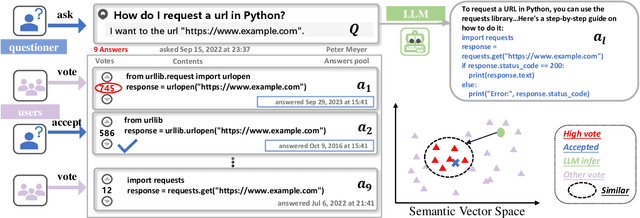
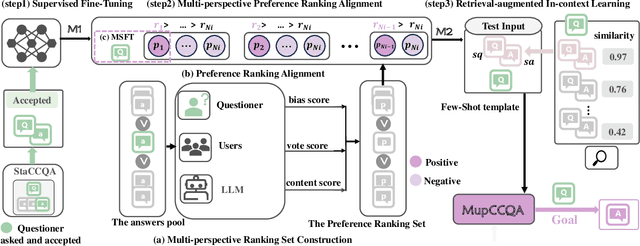
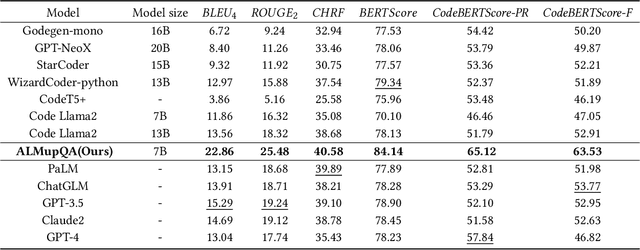
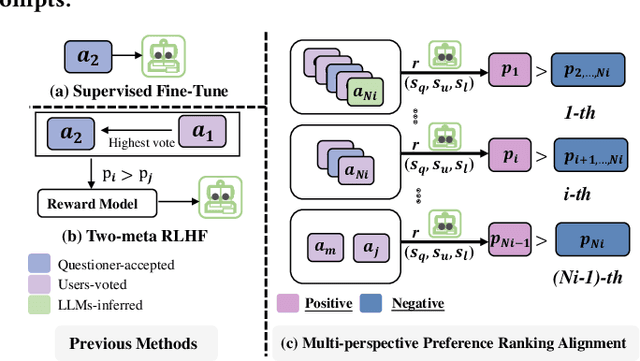
Abstract:Code Community Question Answering (CCQA) seeks to tackle programming-related issues, thereby boosting productivity in both software engineering and academic research. Recent advancements in Reinforcement Learning from Human Feedback (RLHF) have transformed the fine-tuning process of Large Language Models (LLMs) to produce responses that closely mimic human behavior. Leveraging LLMs with RLHF for practical CCQA applications has thus emerged as a promising area of study. Unlike standard code question-answering tasks, CCQA involves multiple possible answers, with varying user preferences for each response. Additionally, code communities often show a preference for new APIs. These challenges prevent LLMs from generating responses that cater to the diverse preferences of users in CCQA tasks. To address these issues, we propose a novel framework called Aligning LLMs through Multi-perspective User Preference Ranking-based Feedback for Programming Question Answering (ALMupQA) to create user-focused responses. Our approach starts with Multi-perspective Preference Ranking Alignment (MPRA), which synthesizes varied user preferences based on the characteristics of answers from code communities. We then introduce a Retrieval-augmented In-context Learning (RIL) module to mitigate the problem of outdated answers by retrieving responses to similar questions from a question bank. Due to the limited availability of high-quality, multi-answer CCQA datasets, we also developed a dataset named StaCCQA from real code communities. Extensive experiments demonstrated the effectiveness of the ALMupQA framework in terms of accuracy and user preference. Compared to the base model, ALMupQA showed nearly an 11% improvement in BLEU, with increases of 20% and 17.5% in BERTScore and CodeBERTScore, respectively.
AdaptSSR: Pre-training User Model with Augmentation-Adaptive Self-Supervised Ranking
Oct 24, 2023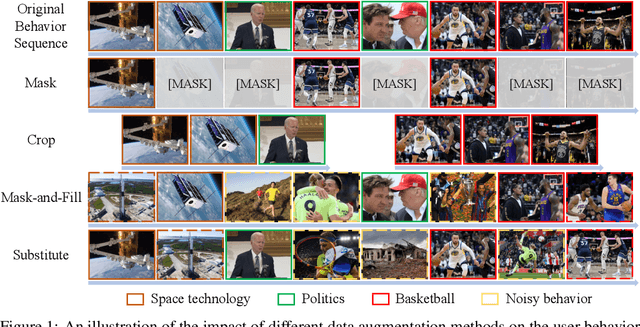

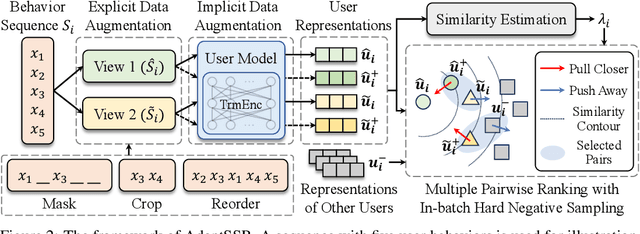
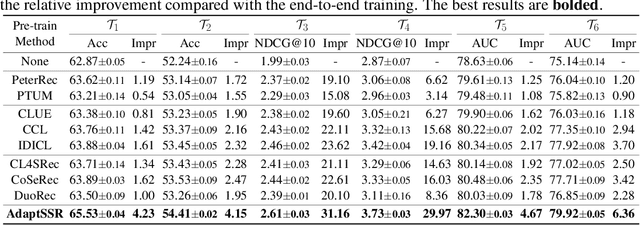
Abstract:User modeling, which aims to capture users' characteristics or interests, heavily relies on task-specific labeled data and suffers from the data sparsity issue. Several recent studies tackled this problem by pre-training the user model on massive user behavior sequences with a contrastive learning task. Generally, these methods assume different views of the same behavior sequence constructed via data augmentation are semantically consistent, i.e., reflecting similar characteristics or interests of the user, and thus maximizing their agreement in the feature space. However, due to the diverse interests and heavy noise in user behaviors, existing augmentation methods tend to lose certain characteristics of the user or introduce noisy behaviors. Thus, forcing the user model to directly maximize the similarity between the augmented views may result in a negative transfer. To this end, we propose to replace the contrastive learning task with a new pretext task: Augmentation-Adaptive SelfSupervised Ranking (AdaptSSR), which alleviates the requirement of semantic consistency between the augmented views while pre-training a discriminative user model. Specifically, we adopt a multiple pairwise ranking loss which trains the user model to capture the similarity orders between the implicitly augmented view, the explicitly augmented view, and views from other users. We further employ an in-batch hard negative sampling strategy to facilitate model training. Moreover, considering the distinct impacts of data augmentation on different behavior sequences, we design an augmentation-adaptive fusion mechanism to automatically adjust the similarity order constraint applied to each sample based on the estimated similarity between the augmented views. Extensive experiments on both public and industrial datasets with six downstream tasks verify the effectiveness of AdaptSSR.
Low-dose CT reconstruction by self-supervised learning in the projection domain
Mar 14, 2022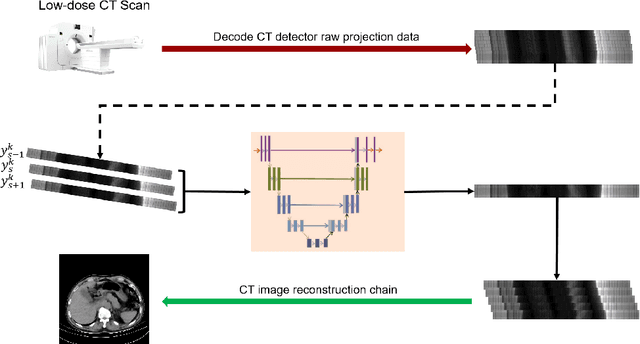


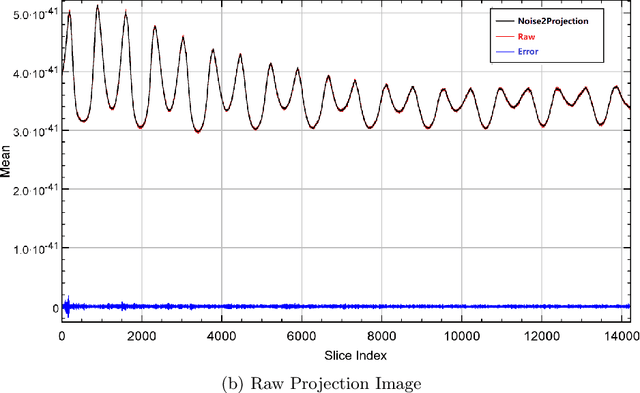
Abstract:In the intention of minimizing excessive X-ray radiation administration to patients, low-dose computed tomography (LDCT) has become a distinct trend in radiology. However, while lowering the radiation dose reduces the risk to the patient, it also increases noise and artifacts, compromising image quality and clinical diagnosis. In most supervised learning methods, paired CT images are required, but such images are unlikely to be available in the clinic. We present a self-supervised learning model (Noise2Projection) that fully exploits the raw projection images to reduce noise and improve the quality of reconstructed LDCT images. Unlike existing self-supervised algorithms, the proposed method only requires noisy CT projection images and reduces noise by exploiting the correlation between nearby projection images. We trained and tested the model using clinical data and the quantitative and qualitative results suggest that our model can effectively reduce LDCT image noise while also drastically removing artifacts in LDCT images.
 Add to Chrome
Add to Chrome Add to Firefox
Add to Firefox Add to Edge
Add to Edge